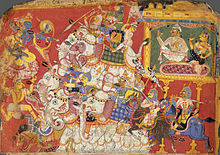Narakasura
This article includes a list of general references, but it lacks sufficient corresponding inline citations. (April 2013) |
| Narakasura | |
|---|---|
 Krishna and Satyabhama fighting Narakasura's armies -Painting from the Metropolitan Museum |
In the Srimad Bhagavatam, Narakasura or Naraka is the asura son of the earth goddess Bhudevi (Bhumi) and Varaha (third avatar of Vishnu) and is said to have grown to be a demon through association with Banasura.[1] He is said to have established the kingdom of Pragjyotisha after overthrowing the last of the Danava king Ghatakasura.
It was foretold that he would be destroyed by a later incarnation of Vishnu. His mother, the earth, sought the boon from Vishnu that her son should have a long life, and that he should be all powerful. Vishnu granted these boons. The legend of Narakasura is important in the history of Assam, particularly Kamarupa; since Narakasura is cited as the progenitor of many dynasties that ruled Kamarupa in historical times. A hill, to the south of Guwahati is named after him. He is also associated with the Hindu belief of the shakti goddess and place of worship Kamakhya.
Legend
This section may need to be rewritten to comply with Wikipedia's quality standards, as The following two paragraphs need reliable citation as well as copy-rewriting to correct semantic inconsistencies.. (May 2009) |

Narakasura became evil, in association with another Asura named Banasura. Drunk with power, as he knew himself to be unrivalled in prowess, he brought all the kingdoms on earth under his control. Next, he turned his eyes towards Swargaloka. Even the mighty Indra could not withstand the assault of this son of Earth and had to flee the heavens. Narakasura had become the overlord of both the heavens and earth. Addicted to power, he stole the earrings of Aditi, the heavenly mother goddess, and usurped some of her territory, while also kidnapping 16000 women.[2]
All the Devas, led by Indra went to Vishnu, to ask him to deliver them from Narakasura. Vishnu promised them that he would attend to this matter, when he would be incarnated as Krishna. As promised to Mother Earth, Narakasura was allowed to enjoy a long reign. At last Vishnu was born as Krishna. Aditi, who was a relative of Krishna's wife Satyabhama (believed to be an Avatar of Bhudevi - Narakasura' mother), approached Satyabhama for help. When Satyabhama heard of the Narakasura's ill treatment of women and his behaviour with Aditi, she was enraged. Satyabhama approached Lord Krishna for permission to wage a war against Narakasura. As promised to the Devas and Aditi, Krishna attacked the great fortress of Narakasura, riding his mount Garuda with wife Satyabhama.
Lord Krishna used the Narayanastra and the Agneyastra against the army of Narakasura. The battle was furiously fought. Narakasura possessed 11 Akshauhinis that he unleashed on Lord Krishna. However, the Lord slew them all with little effort. Lord Krishna also killed Mura, Narakasura's general. Thus Krishna is called 'Murāri' (the killer of Mura). Narakasura used several divine weapons against Lord Krishna, but Krishna easily neutralised all those weapons. Narakasura used the Brahmastra against Lord Krishna, but Lord Krishna neutralised it with his own Brahmastra. Narakasura used the Agneyastra against Lord Krishna, but Lord Krishna neutralised it with the Varunastra. Narakasura used the Nagapasha against Lord Krishna, but Lord Krishna neutralised it with the Garudastra. In desperation, Narakasura launched the Vaishnavastra on Lord Krishna, but Lord Krishna neutralised it with another Vaishnavastra. At last, when Narakasura tried to kill Lord Krishna with a trident, Lord Krishna beheaded him with his Sudarshana Chakra (discus).
Before Narakasura's death, he requested a boon from his mother, Satyabhama, that everyone should celebrate his death with colorful light. Thus this day is celebrated as 'Naraka Chaturdashi' - the day before Diwali. Krishna's and Satyabhama's victory on Narakasura translated into freedom for all his prisoners and honoring of Aditi. Having rescued the 16,100 women, Krishna married them to restore them to their former dignity.
History
Narakasura and his kingdom, Pragjyotisha, find mention in both the Mahabharata and the Ramayana, in the sections which were written before 500Century B.C.. His son, Bhagadatta, is said to have fought for the Kauravas in the Mahabharata battle. Though the boar Prajapati finds mention as early as the Satapatha Brahmana, that the contact with Bhumi engendered a son is first mentioned in the Harivamsa which is assigned to the fifth century. This theme, that of the son Naraka, is further expanded in the later Vishnu Purana. The Bhagavata Purana, which was composed even later, expands the story even further.
The Naraka legend gets the most extensive elaboration in the Upapurana called Kalika Purana (10th century), which was composed in Assam itself. Here the myth of Janaka of Videha, the father of Sita, is embellished and added to the myth of Naraka.
References
- ^ Srimad Bhagavatam. The Bhaktivedanta Book Trust International, Inc. p. 3.3.6.
- ^ Swami, Parmeshwaranand (2001). Encyclopaedic Dictionary of the Puranas. New Delhi: Sarup and Sons. p. 941. ISBN 8176252263.
Bibliography
- Epico-Puranic Myths and Allied Legends, D. C. Sircar, in The Comprehensive History of Assam, Vol 1, ed H. K. Barpujari 1990.
- Vettam Mani, Puranic Encyclopaedia.
